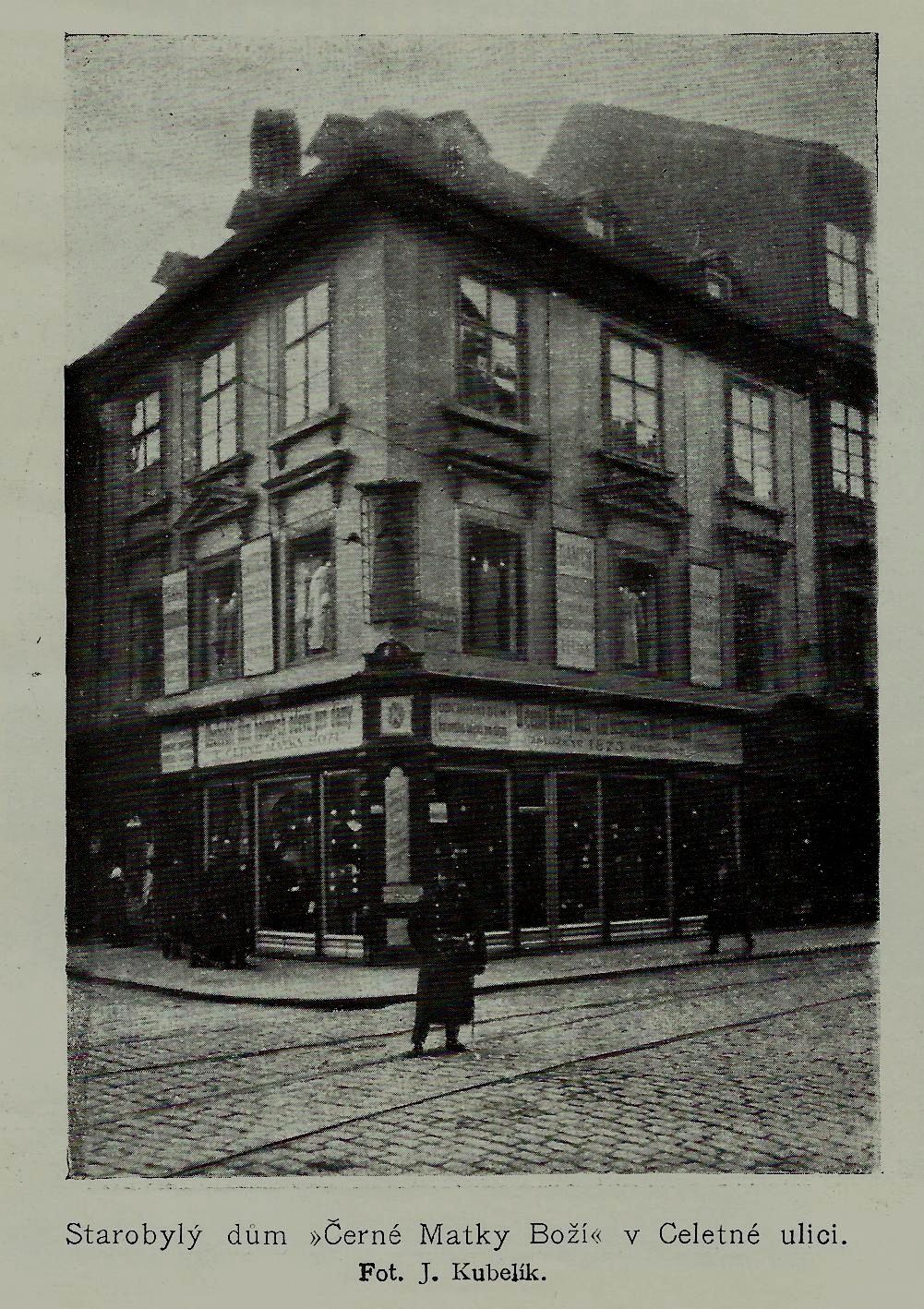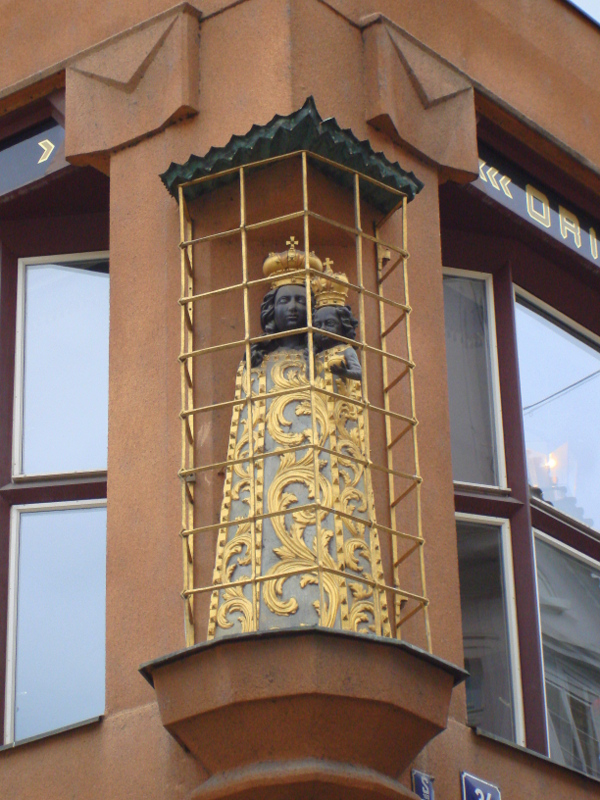House of the Black Madonna on:
[Wikipedia]
[Google]
[Amazon]
 The House of the Black Madonna (
The House of the Black Madonna (
 Gočár designed the house in mid-1911 at the age of 31 for the wholesale merchant František Josef Herbst. Herbst chose Gočár to build his
Gočár designed the house in mid-1911 at the age of 31 for the wholesale merchant František Josef Herbst. Herbst chose Gočár to build his  Herbst’s department store and the attached café occupied the ground and second floor of the building, above which were apartments. After the department store closed in 1922, the first two floors were converted to bank offices. Further alterations to the architectural integrity were made in 1941, when functionalist architect V. Kubik refashioned the wooden frames on the ground floor windows with steel. During the communist period, the building was further subdivided office space for the National Enterprise Exhibition.
Herbst’s department store and the attached café occupied the ground and second floor of the building, above which were apartments. After the department store closed in 1922, the first two floors were converted to bank offices. Further alterations to the architectural integrity were made in 1941, when functionalist architect V. Kubik refashioned the wooden frames on the ground floor windows with steel. During the communist period, the building was further subdivided office space for the National Enterprise Exhibition.
 In 1994, the building was thoroughly renovated and made a center for Czech art and culture. After further renovation works between 2002 and 2003, the building was made home to the Museum of Czech Cubism, operated by the Prague Museum of Decorative Arts. The second and third floors are dedicated to a permanent exhibition of Cubist art, while the upper floors are used for temporary exhibitions and workshops. Although few original plans had survived, black-and-white photographs documenting the café's interior décor from 1912 were used during renovation. Replicas of café furniture and brass chandeliers were constructed to revive the café and showcase Czech cubism to customers.
In 1994, the building was thoroughly renovated and made a center for Czech art and culture. After further renovation works between 2002 and 2003, the building was made home to the Museum of Czech Cubism, operated by the Prague Museum of Decorative Arts. The second and third floors are dedicated to a permanent exhibition of Cubist art, while the upper floors are used for temporary exhibitions and workshops. Although few original plans had survived, black-and-white photographs documenting the café's interior décor from 1912 were used during renovation. Replicas of café furniture and brass chandeliers were constructed to revive the café and showcase Czech cubism to customers.
Cubist House of the Black Madonna re-opens in Prague - Czech RadioHouse at the Black Madonna - Museum of Czech CubismHouse at the Black Madonna at www.prague-museums.com
{{authority control Cubism Museums in Prague Art museums and galleries in the Czech Republic Art museums established in 2003 National Cultural Monuments of the Czech Republic Art Nouveau architecture in Prague Art Nouveau retail buildings Josef Gočár buildings Commercial buildings completed in 1912 1912 establishments in Austria-Hungary Coffeehouses and cafés in the Czech Republic Chicago school (architecture) Restaurants in Prague
Czech
Czech may refer to:
* Anything from or related to the Czech Republic, a country in Europe
** Czech language
** Czechs, the people of the area
** Czech culture
** Czech cuisine
* One of three mythical brothers, Lech, Czech, and Rus'
Places
* Czech, ...
: ''U Černé Matky Boží'') is a cubist
Cubism is an early-20th-century avant-garde art movement that revolutionized European painting and sculpture, and inspired related movements in music, literature and architecture. In Cubist artwork, objects are analyzed, broken up and reassemble ...
building in the Old Town of Prague
Prague ( ; cs, Praha ; german: Prag, ; la, Praga) is the capital and List of cities in the Czech Republic, largest city in the Czech Republic, and the historical capital of Bohemia. On the Vltava river, Prague is home to about 1.3 milli ...
, Czech Republic
The Czech Republic, or simply Czechia, is a landlocked country in Central Europe. Historically known as Bohemia, it is bordered by Austria to the south, Germany to the west, Poland to the northeast, and Slovakia to the southeast. The ...
. It was designed by Josef Gočár
Josef Gočár (13 March 1880 in Semín – 10 September 1945 in Jičín) was a Czech architect. It was one of the founders of modern architecture in Czech Republic.
Life
Josef Gočár received his early instruction at the State Technical School ...
. The first floor houses a café, while the four upper floors are used by the Museum of Czech Cubism.
The building, completed in 1912, is named after the baroque sculpture of a Black Madonna
The term ''Black Madonna'' or ''Black Virgin'' tends to refer to statues or paintings in Western Christendom of the Blessed Virgin Mary and the Infant Jesus, where both figures are depicted with dark skin. The Black Madonna can be found both ...
that adorns it, a remnant of an earlier building on the site. It is the earliest example of cubist architecture in Prague. After years of alteration and damage to the original fabric of the building, it was fully restored in 2003.
History
 Gočár designed the house in mid-1911 at the age of 31 for the wholesale merchant František Josef Herbst. Herbst chose Gočár to build his
Gočár designed the house in mid-1911 at the age of 31 for the wholesale merchant František Josef Herbst. Herbst chose Gočár to build his department store
A department store is a retail establishment offering a wide range of consumer goods in different areas of the store, each area ("department") specializing in a product category. In modern major cities, the department store made a dramatic app ...
because of the architect’s success building the modernist
Modernism is both a philosophy, philosophical and arts movement that arose from broad transformations in Western world, Western society during the late 19th and early 20th centuries. The movement reflected a desire for the creation of new fo ...
Wenke Department Store in Jaroměř
Jaroměř (; german: Jermer) is a town in Náchod District in the Hradec Králové Region of the Czech Republic. It has about 12,000 inhabitants. It is known for the Josefov Fortress. Josefov is well preserved and is protected by law as an urban ...
, built from 1909-1911.
The demolition of the baroque building on the site was controversial, and Gočár’s early modernist plans for the site were not well received by the historical buildings authority. Because of its prominent location in the heart of the city, Gočár’s building was subject to strict harmonization rules requiring that the department store not conflict with its historical setting. Thus, Gočár contextualized the building in its historic surroundings through its use of baroque forms. The Prague City Council eventually approved the plans on August 4, 1911.
Like many of Gočár’s buildings, the House of the Black Madonna was built with a reinforced-concrete skeleton inspired by the Chicago School. The use of a reinforced-concrete skeleton allowed for large interior spaces without ceiling support, which was better suited to Cubist aesthetics. The first floor café, free of interior pillars, was a feat of engineering at the time.
References
External links
Cubist House of the Black Madonna re-opens in Prague - Czech Radio
{{authority control Cubism Museums in Prague Art museums and galleries in the Czech Republic Art museums established in 2003 National Cultural Monuments of the Czech Republic Art Nouveau architecture in Prague Art Nouveau retail buildings Josef Gočár buildings Commercial buildings completed in 1912 1912 establishments in Austria-Hungary Coffeehouses and cafés in the Czech Republic Chicago school (architecture) Restaurants in Prague